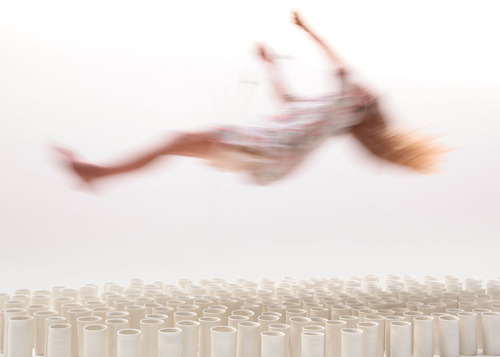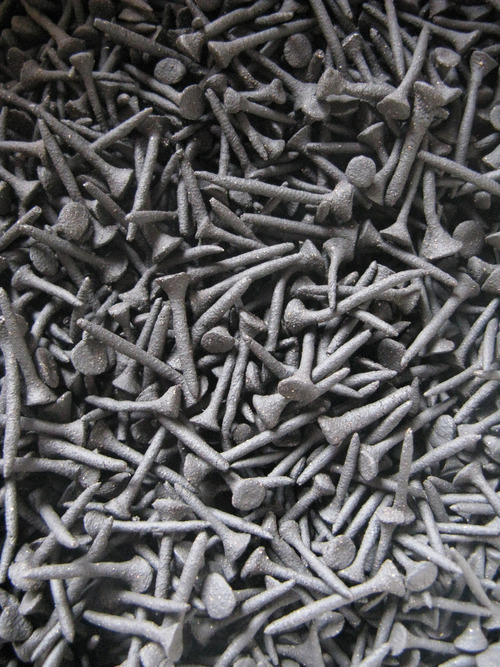
Your body of work consists in reinterpretations in stoneware and porcelain of everyday objects. What sparked your interest for ceramics?
Firstly, an attraction toward the household objects led me to ceramic. I am deeply fascinated by clay and the gesture of the hand cupping the bowl.
Beyond the objects, my interest for this art was aroused by a strong link with the origin of humankind, the ancestral tradition of making household objects out of that universal and natural clay. Finally, meeting with ceramists and contemplating their work was a strong incentive to become part of that story.
The refinement and suaveness of your ceramic pieces are given by your attention to detail. Tell us about your educational background and other related experiences.
I had numerous trainings in France and Belgium with ceramists, during which I learned, observed and appreciated the simplicity of the gesture of the first movement. Permanently, I think of the first gestures man performed in order to create a clay or stoneware object.
I love the primitive aspect of this job whose rules have not changed for thousands of years.
How did the architecture of the North of France and the austere aesthetic of the Flemish still-life affected your work?
I am of Flemish origins, I have always lived in the North of France. I don’t believe in plain inspiration, it comes through our environment and culture. In my region and in the near Belgium country more particularly, the black color is omnipresent: in my ancestors clothes, in the colors of the walls, in Flemish paintings. When I walk around cities like Amsterdam or Gand, or along the enbankment in Anvers Harbor, or wandering in Bruxelles, what strikes me is the simplicity and efficiency of architecture, either XVIth century and ultra-contemporary. Streamlined shapes, huge openings to catch maximum light in spite of often grey skies.
My country is also a landscape of industrial wasteland. Former silos, unused steel factories, traces of a bygone industry in which concrete and rusty steel beams are the ghosts of that prosperous era.

Virginie Besengez, Brimming Over, 2012, Stoneware and porcelain, Diam. 50 cm x H. 40 cm.
The monochrome compositions that you create give the viewer a subtle remembrance of the object design of the 60’s. Why did you choose not to use color in your works?
Color makes no sense to me, for me it takes too much space and leaves no room for subtlety and details. You need to have a poetic mind to be moved by the grey sea of the North, by the dull skies of Flanders.
Grey and black change according to the light, they are not permanent, thus the object has several lives in one day. I am particularly interested in the numerous shades of grey that light can enhance in a monochrome composition, depending on the clay, its closeness to an immaculate porcelain and the way pieces are laid out.
I have been influenced and inspired by Morandi, but also by urban wastelands, steel compression ready for recycling, odds and ends piled up at the back of an old scottish shop.
For how long have you been working as a full-time ceramic artist? Do you feel connected to other artist’s works from France and to the cultural heritage of the place you live in?
I have been working as a ceramist for 12 years and have had the opportunity to build ties of friendship with french and foreign ceramists, but also photographers, filmmakers and painters. We have regular meetings during which we share our experience, doubts and questions in an atmosphere of complicity. Those meetings are crucial for me.

Virginie Besengez, Nails, 2010, Stoneware, Variable dimensions.
Are you currently working on a new project? What can we see your works in the near future?
I am currently working on a porcelain installation project, in collaboration with a graphic artist. Our activities are complementary, we debate on our differences and share our feelings. This experience gives a a true meaning to my work, and my aim through my exhibitions is to express, denounce and to raise awareness about subjects that I’m concerned about. I am now turning a new leaf, planning my exhibitions more as a ground for debate, exchange, complicity and dialogue with other artists in common projects.
Interview by Vasi Hirdo, published in Ceramics Now Magazine, Issue 2.
Visit Virginie Besengez’s website.
View the list of interviews with ceramic artists.



















